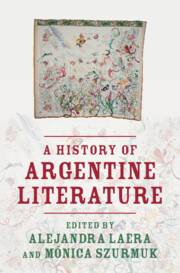Book contents
- A History of Argentine Literature
- A History of Argentine Literature
- Copyright page
- Contents
- Figures
- Contributors
- Editors’ Acknowledgments
- Introduction
- Part I Literary Dates
- Part II Critical Inroads
- Chapter 11 Print Culture in the Nineteenth Century
- Chapter 12 Criollismo: Gauchos in Literature and Film
- Chapter 13 Race and Nation
- Chapter 14 Science in Argentine Literature
- Chapter 15 Essay and Territory: The Geography of National Identity
- Chapter 16 Music as Sonic Literature
- Chapter 17 The Jewish Presence in Argentine Literature
- Chapter 18 Emancipation: Twentieth-Century Female Writers, Journalists, and Activists
- Chapter 19 Forsaking Tradition: Dislocating the Sovereignty of Argentine Literature
- Chapter 20 Mujeres raras: Patriarchal Nightmares, Dissident Imagination
- Part III Literary Names
- Index
- References
Chapter 11 - Print Culture in the Nineteenth Century
from Part II - Critical Inroads
Published online by Cambridge University Press: 09 May 2024
- A History of Argentine Literature
- A History of Argentine Literature
- Copyright page
- Contents
- Figures
- Contributors
- Editors’ Acknowledgments
- Introduction
- Part I Literary Dates
- Part II Critical Inroads
- Chapter 11 Print Culture in the Nineteenth Century
- Chapter 12 Criollismo: Gauchos in Literature and Film
- Chapter 13 Race and Nation
- Chapter 14 Science in Argentine Literature
- Chapter 15 Essay and Territory: The Geography of National Identity
- Chapter 16 Music as Sonic Literature
- Chapter 17 The Jewish Presence in Argentine Literature
- Chapter 18 Emancipation: Twentieth-Century Female Writers, Journalists, and Activists
- Chapter 19 Forsaking Tradition: Dislocating the Sovereignty of Argentine Literature
- Chapter 20 Mujeres raras: Patriarchal Nightmares, Dissident Imagination
- Part III Literary Names
- Index
- References
Summary
At the beginning of the nineteenth century the term “literature” was used broadly to describe any printed text. By the turn of the century, its meaning had narrowed to refer specifically to aesthetic verbal objects with distinctive features of authorship and form. This change was brought on by rapid transformations in print culture. Literature created its readership mainly through periodicals: newspapers, leaflets, pamphlets, illustrated weeklies, magazines of mass and high culture. Periodicals were not only the medium for all literary genres but were also key in the professionalization of writers and the making of national literatures. They were a powerful tool to shape the literary imagination of a growing and increasingly more diversified reading public. Through the publication of serialized novels, essays, and reviews, periodicals such as La Nación, Sud-América, and Caras y Caretas were essential to the process of literary autonomy in Argentina. In this chapter the history of this process is outlined and those cases in which developments in print culture framed some of the most significant works of Argentine literature are discussed.
- Type
- Chapter
- Information
- A History of Argentine Literature , pp. 165 - 183Publisher: Cambridge University PressPrint publication year: 2024



